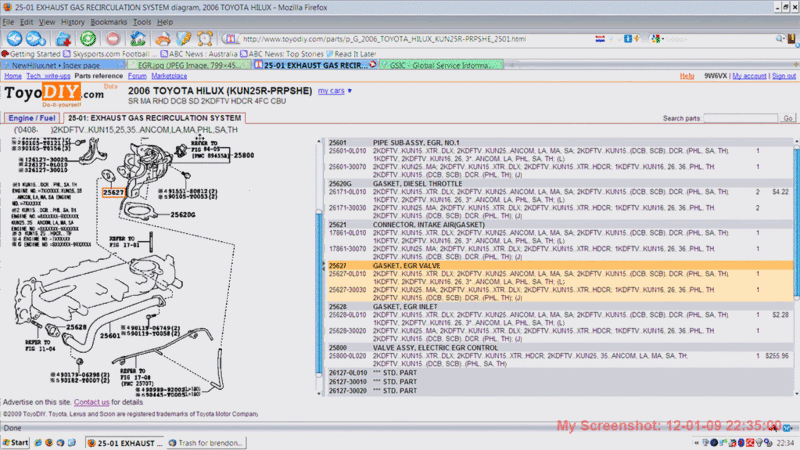EGR valve block off
Re: EGR valve block off
Guys,
I actually blocked off the EGR valve last week.
The mechanic took about an hour to block it off.
In real world conditions, I feel slightly better acceleration. My other mates who have also blocked the EGR valve on thier Hilux also commented on the slight improvement in acceleration.
I actually blocked off the EGR valve last week.
The mechanic took about an hour to block it off.
In real world conditions, I feel slightly better acceleration. My other mates who have also blocked the EGR valve on thier Hilux also commented on the slight improvement in acceleration.
Cheers
Brendon
73 de 9W6VX
Brendon
73 de 9W6VX
-

9W6VX - Site Admin
- Posts: 6733
- Joined: Sun, 07 Jan 2007 12:00 +0000
- Location: KK - The Land Below The Wind, Not in OZ
Re: EGR valve block off
hahaha! see!!!!!
good work Brendon.

good work Brendon.
"These words carry so much weight they would break a less awesome mans jaw..."
-

Ox Man - Posts: 869
- Joined: Sun, 12 Jul 2009 4:06 +0000
- Location: The Jungle
Re: EGR valve block off
brendan, where in the system did he block it off exactly?
The Punisher 2.0 N80 Build - http://www.newhilux.net/phpbb/viewtopic.php?f=119&t=26631
The Punisher 1.0 N70 Build - http://www.newhilux.net/phpbb/viewtopic.php?f=41&t=747&hilit=Punisher
The Punisher 1.0 N70 Build - http://www.newhilux.net/phpbb/viewtopic.php?f=41&t=747&hilit=Punisher
-

Hilux Max - Valued Contributor
- Posts: 12434
- Joined: Sun, 07 Jan 2007 12:00 +0000
Re: EGR valve block off
Max,
Mine will be different from the Aussie 1KD-FTV's 3litre D4D.
I'll try to post some pictures up later on my 2KD-FTV 2.5 litre D4D.
Mine will be different from the Aussie 1KD-FTV's 3litre D4D.
I'll try to post some pictures up later on my 2KD-FTV 2.5 litre D4D.
Cheers
Brendon
73 de 9W6VX
Brendon
73 de 9W6VX
-

9W6VX - Site Admin
- Posts: 6733
- Joined: Sun, 07 Jan 2007 12:00 +0000
- Location: KK - The Land Below The Wind, Not in OZ
Re: EGR valve block off
Here you go.
The version for Malaysia (MA), Philippines (PH), Thailand (TH), South Africa (SA) do not have the EGR cooler.
If I remember correctly it was blocked off at 25627.
The picture you posted earlier Max is with the EGR cooler as the 2KD-FTV's with EGR cooler are also quite similar to the 1KD that you have in OZ.
When I compare the 1KD's without EGR cooler, it's similar to my 2KD without the EGR cooler.
I know it doesn't offer much help but I reckon no harm in trying it out on your Aussie specced engines.

The version for Malaysia (MA), Philippines (PH), Thailand (TH), South Africa (SA) do not have the EGR cooler.
If I remember correctly it was blocked off at 25627.
The picture you posted earlier Max is with the EGR cooler as the 2KD-FTV's with EGR cooler are also quite similar to the 1KD that you have in OZ.
When I compare the 1KD's without EGR cooler, it's similar to my 2KD without the EGR cooler.
I know it doesn't offer much help but I reckon no harm in trying it out on your Aussie specced engines.

Cheers
Brendon
73 de 9W6VX
Brendon
73 de 9W6VX
-

9W6VX - Site Admin
- Posts: 6733
- Joined: Sun, 07 Jan 2007 12:00 +0000
- Location: KK - The Land Below The Wind, Not in OZ
Re: EGR valve block off
Hi guys my first post here but please dont have a moan at me as i havent said HELLO.
Any way i have read all of this thread and find it very interesting on what all people say, the thing with EGR is, we all know that hot gas going into the engine wont burn like cold gas, the mess it leaves in the intake manifold and ports.
Has any one ever looked at it this way, if we have dirty old gas going in there surely this is taking up space for precious OXYGEN ?
BUT the biggest thing you have all missed is the the VALVE that lets the exhaust gas into the inlet is partly taking up space and RESTRICTING air flow through the inlet system, On all vehicles i make EGR pipes for the porpous of doing it is BOTH of the above "stop dirty old gas getting back into the engine and opening up / un restricting the air flow into the engine".
I have done a TD4 freelander (bmw 2 litre diesel engine) by removing the actual valve unit you gain an extra 40% air flow / area..
streffie
Any way i have read all of this thread and find it very interesting on what all people say, the thing with EGR is, we all know that hot gas going into the engine wont burn like cold gas, the mess it leaves in the intake manifold and ports.
Has any one ever looked at it this way, if we have dirty old gas going in there surely this is taking up space for precious OXYGEN ?
BUT the biggest thing you have all missed is the the VALVE that lets the exhaust gas into the inlet is partly taking up space and RESTRICTING air flow through the inlet system, On all vehicles i make EGR pipes for the porpous of doing it is BOTH of the above "stop dirty old gas getting back into the engine and opening up / un restricting the air flow into the engine".
I have done a TD4 freelander (bmw 2 litre diesel engine) by removing the actual valve unit you gain an extra 40% air flow / area..
streffie
I was Trying to buy a new invincible but dealers are useless, but i found a good one and now have 5-6 weeks to wait as from 04-01-10
- streffie
- Posts: 32
- Joined: Wed, 09 Dec 2009 6:42 +0000
- Location: Midlands UK
Re: EGR valve block off
Streffie,
Don't mean to get into an argument with you but when intake manifolds are designed they are designed for peak air flow with a known inlet depression. EGR feed pipes are taken into account for these calcs.
The majority of modern (Euro III onwards) engines have EGR coolers which means the exhaust gases are cooled prior to being entrained into the inlet air.
EGR feed is designed to take the place of oxygen. EGR is only used in part load conditions to ensure that the AFR is tightly controlled meaning the burn is more efficient and the emissions are lower. (Have a look at my previous post on thinking of EGR as an inert gas). EGR is switched off under full load so that the engine can be squirted with as much fuel as the smoke limitation algorithms in the ECU will allow. if you want more power than that then you need to over fuel and get a bigger turbo (and and and!!).
Any 'gunk' in that the EGR returns to the inlet manifold is tested to death durign validation (at least on the engine programs I worked on). EGR induced soot build up in the intake manifold was always a concern and is designed out as much as possible (mostly by ensuring that sensors are positioned appropriately, etc and that coolers are sized appropriately and EGR valves are stroked regularly to clean the valve stems).
Cheers.
Don't mean to get into an argument with you but when intake manifolds are designed they are designed for peak air flow with a known inlet depression. EGR feed pipes are taken into account for these calcs.
The majority of modern (Euro III onwards) engines have EGR coolers which means the exhaust gases are cooled prior to being entrained into the inlet air.
EGR feed is designed to take the place of oxygen. EGR is only used in part load conditions to ensure that the AFR is tightly controlled meaning the burn is more efficient and the emissions are lower. (Have a look at my previous post on thinking of EGR as an inert gas). EGR is switched off under full load so that the engine can be squirted with as much fuel as the smoke limitation algorithms in the ECU will allow. if you want more power than that then you need to over fuel and get a bigger turbo (and and and!!).
Any 'gunk' in that the EGR returns to the inlet manifold is tested to death durign validation (at least on the engine programs I worked on). EGR induced soot build up in the intake manifold was always a concern and is designed out as much as possible (mostly by ensuring that sensors are positioned appropriately, etc and that coolers are sized appropriately and EGR valves are stroked regularly to clean the valve stems).
Cheers.
- Carlewy
- Posts: 25
- Joined: Sat, 01 Aug 2009 12:54 +0000
Re: EGR valve block off
any more news on this as im keen as to block mine off
cheers Troy
cheers Troy
-

KTM525EXC - Posts: 6114
- Joined: Thu, 17 Apr 2008 1:00 +0000
- Location: ADELAIDE, SA
Re: EGR valve block off
Hi all, new here,
Found some facts that you might be interested in...
EGR in diesel engines
In modern diesel engines, the EGR gas is cooled through a heat exchanger to allow the introduction of a greater mass of recirculated gas. Unlike SI (spark-ignited) engines, diesels are not limited by the need for a contiguous flamefront; furthermore, since diesels always operate with excess air, they benefit from EGR rates as high as 50% (at idle, where there is otherwise a very large amount of excess air) in controlling NOx emissions.
Since diesel engines are unthrottled, EGR does not lower throttling losses in the way that it does for SI engines. However, exhaust gas (largely carbon dioxide and water vapor) has a higher specific heat than air, and so it still serves to lower peak combustion temperatures. There are trade offs however. Adding EGR to a diesel reduces the specific heat ratio of the combustion gases in the power stroke. This reduces the amount of power that can be extracted by the piston. EGR also tends to reduce the amount of fuel burned in the power stroke. This is evident by the increase in particulate emissions that corresponds to an increase in EGR. Particulate matter (mainly carbon) that is not burned in the power stroke is wasted energy. Stricter regulations on particulate matter(PM) call for further emission controls to be introduced to compensate for the PM emissions introduced by EGR. The most common is particulate filters in the exhaust system that result in reduced fuel efficiency[citation needed]. Since EGR increases the amount of PM that must be dealt with and reduces the exhaust gas temperatures and available oxygen these filters need to function properly to burn off soot, automakers have had to consider injecting fuel and air directly into the exhaust system to keep these filters from plugging up.
[edit] EGR deletion
EGR deletion in diesel engines is considered justifiable by a wide range of people, including the environmentally conscious. Although deleting the EGR system results in increased NOx levels, hydrocarbon emissions, Particulates, Carbon monoxide and Carbon dioxide are drastically reduced. Furthermore, EGR deletion results in an increase in fuel economy as high as 25%. Exhaust gas recirculated back into the cylinders adds wear-inducing contaminants and causes an increase engine oil acidity, which can result in an inefficient, poorly running engine. The increased level of soot also creates the need for diesel particulate filters to prevent environmental contamination.
[edit] EGR implementations
Usually, an engine recirculates exhaust gas by piping it from the exhaust manifold to the inlet manifold. This design is called external EGR. A control valve (EGR Valve) within the circuit regulates and times the gas flow. Some engine designs perform EGR by trapping exhaust gas within the cylinder by not fully expelling it during the exhaust stroke, which is called internal EGR. A form of internal EGR is used in the rotary Atkinson cycle engine.
EGR can also be used by using a variable geometry turbocharger (VGT) which uses variable inlet guide vanes to build sufficient backpressure in the exhaust manifold. For EGR to flow, a pressure difference is required across the intake and exhaust manifold and this is created by the VGT.
Another method that has been experimented with, is using a throttle in a turbocharged diesel engine to decrease the intake pressure, thereby initiating EGR flow.
Early (1970s) EGR systems were unsophisticated, utilizing manifold vacuum as the only input to an on/off EGR valve; reduced performance and/or drivability were common side effects. Slightly later (mid 1970s to carbureted 1980s) systems included a coolant temperature sensor which didn't enable the EGR system until the engine had achieved normal operating temperature (presumably off the choke valve and therefore less likely to block the EGR passages with carbon buildups, and a lot less likely to stall due to a cold engine). Many added systems like "EGR timers" to disable EGR for a few seconds after a full-throttle acceleration. Vacuum reservoirs and "vacuum amplifiers" were sometimes used, adding to the maze of vacuum hoses under the hood. All vacuum-operated systems, especially the EGR due to vacuum lines necessarily in close proximity to the hot exhaust manifold, were highly prone to vacuum leaks caused by cracked hoses; a condition that plagued early 1970s EGR-equipped cars with bizarre reliability problems (stalling when warm or cold, stalling or misfiring under partial throttle, etc.). Hoses in these vehicles would be checked by doing a vacuum leak test or pressure smoke test, with a professional smoke generator. When testing, smoke escapes from the hose being tested or the vacuum test gage indicates a particular hose is leaking.
Modern systems utilizing electronic engine control computers, multiple control inputs, and servo-driven EGR valves typically improve performance/efficiency with no impact on drivability.
In the past, a fair number of car owners disconnected their EGR systems in an attempt for better performance and some still do. The belief is either EGR reduces power output, causes a build-up in the intake manifold, or believe that the environmental impact of EGR outweighs the Nitrous Oxide emission reductions. Disconnecting an EGR system is usually as simple as unplugging an electrically operated valve or inserting a ball bearing into the vacuum line in a vacuum-operated EGR valve. In most modern engines, disabling the EGR system will cause the computer to display a check engine light. In most cases, a disabled EGR system will cause the car to fail an emissions test.
Hope this makes sense to someone...
Cheers
Kimbo
Found some facts that you might be interested in...
EGR in diesel engines
In modern diesel engines, the EGR gas is cooled through a heat exchanger to allow the introduction of a greater mass of recirculated gas. Unlike SI (spark-ignited) engines, diesels are not limited by the need for a contiguous flamefront; furthermore, since diesels always operate with excess air, they benefit from EGR rates as high as 50% (at idle, where there is otherwise a very large amount of excess air) in controlling NOx emissions.
Since diesel engines are unthrottled, EGR does not lower throttling losses in the way that it does for SI engines. However, exhaust gas (largely carbon dioxide and water vapor) has a higher specific heat than air, and so it still serves to lower peak combustion temperatures. There are trade offs however. Adding EGR to a diesel reduces the specific heat ratio of the combustion gases in the power stroke. This reduces the amount of power that can be extracted by the piston. EGR also tends to reduce the amount of fuel burned in the power stroke. This is evident by the increase in particulate emissions that corresponds to an increase in EGR. Particulate matter (mainly carbon) that is not burned in the power stroke is wasted energy. Stricter regulations on particulate matter(PM) call for further emission controls to be introduced to compensate for the PM emissions introduced by EGR. The most common is particulate filters in the exhaust system that result in reduced fuel efficiency[citation needed]. Since EGR increases the amount of PM that must be dealt with and reduces the exhaust gas temperatures and available oxygen these filters need to function properly to burn off soot, automakers have had to consider injecting fuel and air directly into the exhaust system to keep these filters from plugging up.
[edit] EGR deletion
EGR deletion in diesel engines is considered justifiable by a wide range of people, including the environmentally conscious. Although deleting the EGR system results in increased NOx levels, hydrocarbon emissions, Particulates, Carbon monoxide and Carbon dioxide are drastically reduced. Furthermore, EGR deletion results in an increase in fuel economy as high as 25%. Exhaust gas recirculated back into the cylinders adds wear-inducing contaminants and causes an increase engine oil acidity, which can result in an inefficient, poorly running engine. The increased level of soot also creates the need for diesel particulate filters to prevent environmental contamination.
[edit] EGR implementations
Usually, an engine recirculates exhaust gas by piping it from the exhaust manifold to the inlet manifold. This design is called external EGR. A control valve (EGR Valve) within the circuit regulates and times the gas flow. Some engine designs perform EGR by trapping exhaust gas within the cylinder by not fully expelling it during the exhaust stroke, which is called internal EGR. A form of internal EGR is used in the rotary Atkinson cycle engine.
EGR can also be used by using a variable geometry turbocharger (VGT) which uses variable inlet guide vanes to build sufficient backpressure in the exhaust manifold. For EGR to flow, a pressure difference is required across the intake and exhaust manifold and this is created by the VGT.
Another method that has been experimented with, is using a throttle in a turbocharged diesel engine to decrease the intake pressure, thereby initiating EGR flow.
Early (1970s) EGR systems were unsophisticated, utilizing manifold vacuum as the only input to an on/off EGR valve; reduced performance and/or drivability were common side effects. Slightly later (mid 1970s to carbureted 1980s) systems included a coolant temperature sensor which didn't enable the EGR system until the engine had achieved normal operating temperature (presumably off the choke valve and therefore less likely to block the EGR passages with carbon buildups, and a lot less likely to stall due to a cold engine). Many added systems like "EGR timers" to disable EGR for a few seconds after a full-throttle acceleration. Vacuum reservoirs and "vacuum amplifiers" were sometimes used, adding to the maze of vacuum hoses under the hood. All vacuum-operated systems, especially the EGR due to vacuum lines necessarily in close proximity to the hot exhaust manifold, were highly prone to vacuum leaks caused by cracked hoses; a condition that plagued early 1970s EGR-equipped cars with bizarre reliability problems (stalling when warm or cold, stalling or misfiring under partial throttle, etc.). Hoses in these vehicles would be checked by doing a vacuum leak test or pressure smoke test, with a professional smoke generator. When testing, smoke escapes from the hose being tested or the vacuum test gage indicates a particular hose is leaking.
Modern systems utilizing electronic engine control computers, multiple control inputs, and servo-driven EGR valves typically improve performance/efficiency with no impact on drivability.
In the past, a fair number of car owners disconnected their EGR systems in an attempt for better performance and some still do. The belief is either EGR reduces power output, causes a build-up in the intake manifold, or believe that the environmental impact of EGR outweighs the Nitrous Oxide emission reductions. Disconnecting an EGR system is usually as simple as unplugging an electrically operated valve or inserting a ball bearing into the vacuum line in a vacuum-operated EGR valve. In most modern engines, disabling the EGR system will cause the computer to display a check engine light. In most cases, a disabled EGR system will cause the car to fail an emissions test.
Hope this makes sense to someone...
Cheers
Kimbo
- hippy
- Posts: 1
- Joined: Thu, 11 Feb 2010 4:08 +0000
Re: EGR valve block off
OK, I bit the bullet & after alot of investigation have done the following.
Here is a link to a schematic of the 3.0 engine EGR system:
http://www.toyodiy.com/parts/p_G_200703 ... _2501.html
First I removed the 2 bolts to attempt to make up a blank in place of gasket "25628" as Brendon has done on his, but this also involves loosening a heap of hard to get at bolts so the who EGR cooling system can be moved. So I decided this would be a long & hard job & put it back together. Ideally, I would like a plate installed but that will be further down the track after a bit more testing.
So, from there I removed the vacuum line to the EGR 2 valve "25630" & then folded it over & put a zip tie around it. After I've finished testing I'll block it with a ball bearing & replace it so it looks all factory.
Took it for a test drive & have found the following:
- No error codes appeared
- Turbo boosts up at lower RPM a bit more (hardly noticeable really)
- When coasting down hill the water temp drops 2-3 degrees. My guess is that without the hot exhaust gasses going through the EGR cooler, the cooling system is less stressed.
- Idle down time is much quicker. EGT temps drop noticeably quicker at idle.
I'll do some more testing, but so far so good. This is a quick & easy mod & as long as the EGR electrical controller is not touched, it doesn't seem to affect anything.
Cheers
Tony
Here is a link to a schematic of the 3.0 engine EGR system:
http://www.toyodiy.com/parts/p_G_200703 ... _2501.html
First I removed the 2 bolts to attempt to make up a blank in place of gasket "25628" as Brendon has done on his, but this also involves loosening a heap of hard to get at bolts so the who EGR cooling system can be moved. So I decided this would be a long & hard job & put it back together. Ideally, I would like a plate installed but that will be further down the track after a bit more testing.
So, from there I removed the vacuum line to the EGR 2 valve "25630" & then folded it over & put a zip tie around it. After I've finished testing I'll block it with a ball bearing & replace it so it looks all factory.
Took it for a test drive & have found the following:
- No error codes appeared
- Turbo boosts up at lower RPM a bit more (hardly noticeable really)
- When coasting down hill the water temp drops 2-3 degrees. My guess is that without the hot exhaust gasses going through the EGR cooler, the cooling system is less stressed.
- Idle down time is much quicker. EGT temps drop noticeably quicker at idle.
I'll do some more testing, but so far so good. This is a quick & easy mod & as long as the EGR electrical controller is not touched, it doesn't seem to affect anything.
Cheers
Tony
-

tonymtber - Posts: 188
- Joined: Sat, 02 May 2009 6:24 +0000
Re: EGR valve block off
Nice work Tony.
Good luck with it, looking forward to some more updates.
Cheers
Matt
Good luck with it, looking forward to some more updates.
Cheers
Matt
MONSTER RIDES :: +05 HILUX Specialist
e: sales@monsterrides.com.au
f: http://www.facebook.com/monsterrides
t: 1800 55 44 24
m: 0430 297 444
e: sales@monsterrides.com.au
f: http://www.facebook.com/monsterrides
t: 1800 55 44 24
m: 0430 297 444
-

Monster Rides - Posts: 1516
- Joined: Fri, 26 Jun 2009 7:03 +0000
Re: EGR valve block off
tonymtber wrote:OK, I bit the bullet & after alot of investigation have done the following.
Here is a link to a schematic of the 3.0 engine EGR system:
http://www.toyodiy.com/parts/p_G_200703 ... _2501.html
First I removed the 2 bolts to attempt to make up a blank in place of gasket "25628" as Brendon has done on his, but this also involves loosening a heap of hard to get at bolts so the who EGR cooling system can be moved. So I decided this would be a long & hard job & put it back together. Ideally, I would like a plate installed but that will be further down the track after a bit more testing.
So, from there I removed the vacuum line to the EGR 2 valve "25630" & then folded it over & put a zip tie around it. After I've finished testing I'll block it with a ball bearing & replace it so it looks all factory.
Took it for a test drive & have found the following:
- No error codes appeared
- Turbo boosts up at lower RPM a bit more (hardly noticeable really)
- When coasting down hill the water temp drops 2-3 degrees. My guess is that without the hot exhaust gasses going through the EGR cooler, the cooling system is less stressed.
- Idle down time is much quicker. EGT temps drop noticeably quicker at idle.
I'll do some more testing, but so far so good. This is a quick & easy mod & as long as the EGR electrical controller is not touched, it doesn't seem to affect anything.
Cheers
Tony
So basically all you have just at this stage pulled off the vaccum hose that actuates the value and blocked it off??? Wouldnt this be alot easier to do if it works than blocking off the egr with a plate?? Alot simpler to put back to standard if need be as well.
Josh
Cheers, Josh
My Build Thread: viewtopic.php?f=41&t=8528&start=40
My Shed: http://www.newhilux.net/myshed.php?view=1&id=1538
My Build Thread: viewtopic.php?f=41&t=8528&start=40
My Shed: http://www.newhilux.net/myshed.php?view=1&id=1538
-

Noidea - Posts: 1098
- Joined: Thu, 18 Feb 2010 7:17 +0000
- Location: Hornsby Area, NSW
Re: EGR valve block off
watching with intrest 
-

KTM525EXC - Posts: 6114
- Joined: Thu, 17 Apr 2008 1:00 +0000
- Location: ADELAIDE, SA
Re: EGR valve block off
Yes, correct!
It took me maybe 2 minutes.
Still no signs of any ill affects or warning lights. Definitely a big decrease in the water temp whenever costing down a hill or idling (obviously whenever the EGR was previously open).
The blocking plate would still be my preference (call me paranoid), but it would really be a big job to get everything off & back together again.
Hey KTM, where in the Hills RU? I think I've seen you getting around?
It took me maybe 2 minutes.
Still no signs of any ill affects or warning lights. Definitely a big decrease in the water temp whenever costing down a hill or idling (obviously whenever the EGR was previously open).
The blocking plate would still be my preference (call me paranoid), but it would really be a big job to get everything off & back together again.
Hey KTM, where in the Hills RU? I think I've seen you getting around?
-

tonymtber - Posts: 188
- Joined: Sat, 02 May 2009 6:24 +0000
Re: EGR valve block off
is it worth making this mod a sticky?
"These words carry so much weight they would break a less awesome mans jaw..."
-

Ox Man - Posts: 869
- Joined: Sun, 12 Jul 2009 4:06 +0000
- Location: The Jungle
Re: EGR valve block off
tonymtber wrote:Yes, correct!
It took me maybe 2 minutes.
Still no signs of any ill affects or warning lights. Definitely a big decrease in the water temp whenever costing down a hill or idling (obviously whenever the EGR was previously open).
The blocking plate would still be my preference (call me paranoid), but it would really be a big job to get everything off & back together again.
Hey KTM, where in the Hills RU? I think I've seen you getting around?
Well thanks for being the guinea pig mate, ill be pulling that hose off tomorrow
Cheers, Josh
My Build Thread: viewtopic.php?f=41&t=8528&start=40
My Shed: http://www.newhilux.net/myshed.php?view=1&id=1538
My Build Thread: viewtopic.php?f=41&t=8528&start=40
My Shed: http://www.newhilux.net/myshed.php?view=1&id=1538
-

Noidea - Posts: 1098
- Joined: Thu, 18 Feb 2010 7:17 +0000
- Location: Hornsby Area, NSW
Re: EGR valve block off
Hey tonymtber
i live in Birdwood
i live in Birdwood
-

KTM525EXC - Posts: 6114
- Joined: Thu, 17 Apr 2008 1:00 +0000
- Location: ADELAIDE, SA
Re: EGR valve block off
Hey, I'm just around the corner near Brukunga (5 mins from Woodside)!
-

tonymtber - Posts: 188
- Joined: Sat, 02 May 2009 6:24 +0000
Re: EGR valve block off
Hi All
I blocked my EGR at the head the other day with a blanking plate, I think it gives a litte more grunt but not a great improvement, I like the idea of not sending exhaust back into the inlet manifold. I am now getting a check engine light. I have reset it and it comes back on, not straight away may take 10 or 20Klm. Anyone have any ideas on why it is causing a check engine light on mine 2007 Mod
Noel
I blocked my EGR at the head the other day with a blanking plate, I think it gives a litte more grunt but not a great improvement, I like the idea of not sending exhaust back into the inlet manifold. I am now getting a check engine light. I have reset it and it comes back on, not straight away may take 10 or 20Klm. Anyone have any ideas on why it is causing a check engine light on mine 2007 Mod
Noel
- Noel
- Posts: 50
- Joined: Sat, 12 May 2007 1:00 +0000
- Location: Werribee, VIC
Re: EGR valve block off
any pics Noel on where ya blocked it off?
-

KTM525EXC - Posts: 6114
- Joined: Thu, 17 Apr 2008 1:00 +0000
- Location: ADELAIDE, SA
Who is online
Users browsing this forum: No registered users and 33 guests

